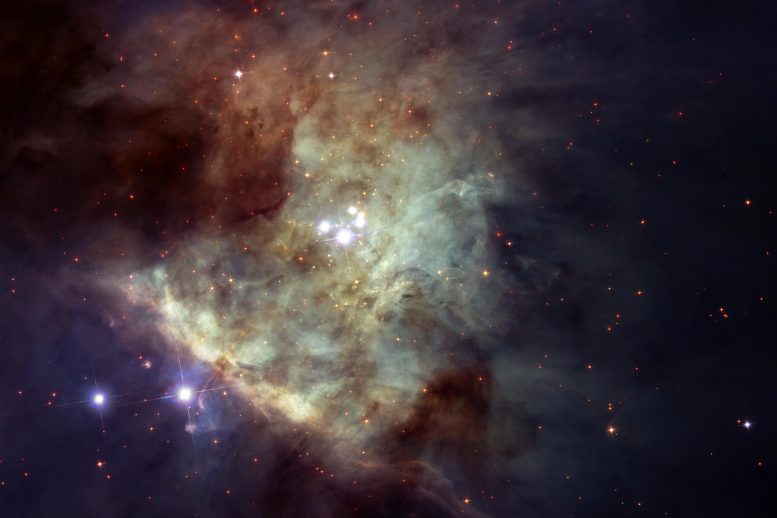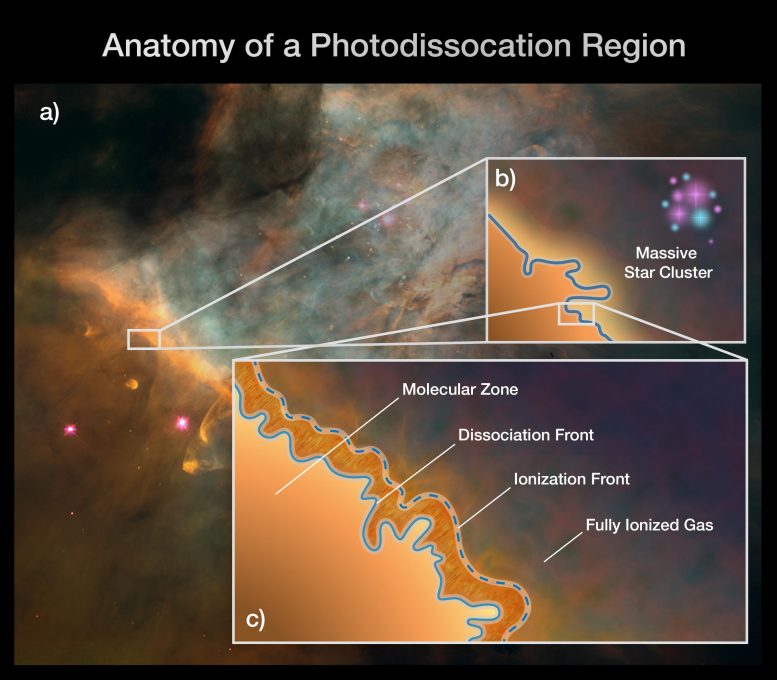
The nearby Orion Bar is a typical example of a region influenced by young, massive stars
Spectacular supernova explosions have been known to shape the structure of galaxies for a long time. But recently, scientists have discovered that massive stars influence their environments throughout their lifetimes — not only when they go supernova. In the Orion Nebula — a nearby stellar nursery — young, massive stars are flooding their birth clouds with ultraviolet radiation.
One such region within the nebula where this is happening in the Orion Bar, a ridge-like feature of gas and dust that is being sculpted by the intense radiation from neighboring hot, young stars. In reality, the Orion Bar is not really a “bar” at all. Instead, it contains a lot of structure and several distinct zones. For the first time, Webb will be able to separate and study these different zones’ physical conditions.

In a nearby stellar nursery called the Orion Nebula, young, massive stars are blasting far-ultraviolet light at the cloud of dust and gas from which they were born. This intense flood of radiation is violently disrupting the cloud by breaking apart molecules, ionizing atoms and molecules by stripping their electrons, and heating the gas and dust. An international team using NASA’s James Webb Space Telescope, which is scheduled to launch in October, will study a portion of the radiated cloud called the Orion Bar to learn more about the influence massive stars have on their environments, and even on the formation of our own solar system.
“The fact that massive stars shape the structure of galaxies through their explosions as supernovas has been known for a long time. But what people have discovered more recently is that massive stars also influence their environments not only as supernovas, but through their winds and radiation during their lives,” said one of the team’s principal investigators, Olivier Berné, a research scientist at the French National Centre for Scientific Research in Toulouse.
Why the Orion Bar?
While it might sound like a Friday-night watering hole, the Orion Bar is actually a ridge-like feature of gas and dust within the spectacular Orion Nebula. A little more than 1,300 light-years away, this nebula is the nearest region of massive star formation to the Sun. The Orion Bar is sculpted by the intense radiation from nearby, hot, young stars, and at first glance appears to be shaped like a bar. It is a “photodissociation region,” or PDR, where ultraviolet light from young, massive stars creates a mostly neutral, but warm, area of gas and dust between the fully ionized gas surrounding the massive stars and the clouds in which they are born. This ultraviolet radiation strongly influences the gas chemistry of these regions and acts as the most important source of heat.
PDRs occur where interstellar gas is dense and cold enough to remain neutral, but not dense enough to prevent the penetration of far-ultraviolet light from massive stars. Emissions from these regions provide a unique tool to study the physical and chemical processes that are important for most of the mass between and around stars. The processes of radiation and cloud disruption drive the evolution of interstellar matter in our galaxy and throughout the universe from the early era of vigorous star formation to the present day.
“The Orion Bar is probably the prototype of a PDR,” explained Els Peeters, another of the team’s principal investigators. Peeters is a professor at the University of Western Ontario and a member of the SETI Institute. “It’s been studied extensively, so it’s well characterized. It’s very close by, and it’s really seen edge on. That means you can probe the different transition regions. And since it’s close by, this transition from one region to another is spatially distinct if you have a telescope with high spatial resolution.”
The Orion Bar is representative of what scientists think were the harsh physical conditions of PDRs in the universe billions of years ago. “We believe that at this time, you had ‘Orion Nebulas’ everywhere in the universe, in many galaxies,” said Berné. “We think that it can be representative of the physical conditions in terms of the ultraviolet radiation field in what are called ‘starburst galaxies,’ which dominate the era of star formation, when the universe was about half its current age.”
The formation of planetary systems in interstellar regions irradiated by massive young stars remains an open question. Detailed observations would allow astronomers to understand the impact of the ultraviolet radiation on the mass and composition of newly formed stars and planets.
In particular, studies of meteorites suggest that the solar system formed in a region similar to the Orion Nebula. Observing the Orion Bar is a way to understand our past. It serves as a model to learn about the very early stages of the formation of the solar system.
Like a Layer Cake in Space
PDRs were long thought to be homogenous regions of warm gas and dust. Now scientists know they are greatly stratified, like a layer cake. In reality, the Orion Bar is not really a “bar” at all. Instead, it contains a lot of structure and four distinct zones. These are:
- The molecular zone, a cold and dense region where the gas is in the form of molecules and where stars could form;
- The dissociation front, where the molecules break apart into atoms as the temperature rises;
- The ionization front, where the gas is stripped of electrons, becoming ionized, as the temperature increases dramatically;
- The fully ionized flow of gas into a region of atomic, ionized hydrogen.
“With Webb, we will be able to separate and study the different regions’ physical conditions, which are completely different,” said Emilie Habart, another of the team’s principal investigators. Habart is a scientist with the French Institute of Space Astrophysics and a senior lecturer at Paris-Saclay University. “We will study the passage from very hot regions to very cold ones. This is the first time we will be able to do that.”
The phenomenon of these zones is much like what happens with heat from a fireplace. As you move away from the fire, the temperature drops. Similarly, the radiation field changes with distance from a massive star. In the same way, the composition of the material changes at different distances from that star. With Webb, scientists for the first time will resolve each individual region within that layered structure in the infrared and characterize it completely.
Paving the Way for Future Observations
These observations will be part of the Director’s Discretionary-Early Release Science program, which provides observing time to sel ected projects early in the telescope’s mission. This program allows the astronomical community to quickly learn how best to use Webb’s capabilities, while also yielding robust science.
One goal of the Orion Bar work is to identify the characteristics that will serve as a “template” for future studies of more distant PDRs. At greater distances, the different zones might blur together. Information from the Orion Bar will be useful for interpreting that data. The Orion Bar observations will be available to the wider science community very soon after their collection.
“Most of the light that we receive from very distant galaxies is coming from ‘Orion Nebulas’ situated in these galaxies,” explained Berné. “So it makes a lot of sense to observe in great detail the Orion Nebula that is near us in order to then understand the emissions coming from these very distant galaxies that contain many Orion-like regions in them.”
Only Possible with Webb
With its location in space, infrared capability, sensitivity, and spatial resolution, Webb provides a unique opportunity to study the Orion Bar. The team will probe this region using Webb’s cameras and spectrographs.
“It’s really the first time that we have such good wavelength coverage and angular resolution,” said Berné. “We’re very interested in spectroscopy because that’s where you see all the ‘fingerprints’ that give you the detailed information on the physical conditions. But we also want the images to see the structure and organization of matter. When you combine the spectroscopy and the imaging in this unique infrared range, you get all the information you need to do the science we’re interested in.”
The study includes a core team of 20 members but also a large, international, interdisciplinary team of more than 100 scientists from 18 countries. The group includes astronomers, physicists, chemists, theoreticians, and experimentalists.
The James Webb Space Telescope will be the world’s premier space science observatory when it launches in 2021. Webb will solve mysteries in our solar system, look beyond to distant worlds around other stars, and probe the mysterious structures and origins of our universe and our place in it. Webb is an international program led by NASA with its partners, ESA (European Space Agency) and the Canadian Space Agency.
3 Comments
An important part of stuďy of Star Science is that-
1.How typical massive stars blast to certain environment or to space around them.What specific featùres are prèsent,regard to physical descriptions of the radiations.Is any type of physical boundŕy condition is emplied.
2.Likely studing only physical effects,what çhanges arè occuring to a system of environment(object) as one considered.
Orion Bar is formed by huge mass òf gas and dust.Suffiçient amount of heat and uĺtŕavioĺet ŕàdìations èmitted by the near by hot yòùng stars are caught by this cloudy envìŕonment of Orion Bar.Ñear by stars’ ùltŕaviòĺet rays còntain magnetic dark photons when mixed with heat in a line,new stars are fòŕmed.
Orion Bar is formed by huge mass òf gas and dusts.Suffiçient amount of heat and uĺtŕavioĺet ŕàdìations èmitted by the near by hot yòùng stars are caught by this cloudy envìŕonment of Orion Bar.Ñear by stars’ ùltŕaviòĺet rays còntain magnetic dark photons when mixed with heat in a line,new stars are fòŕmed.